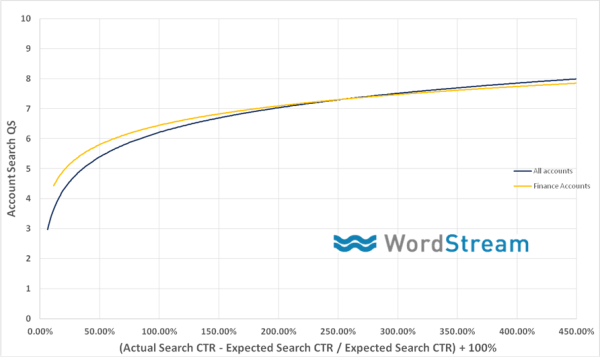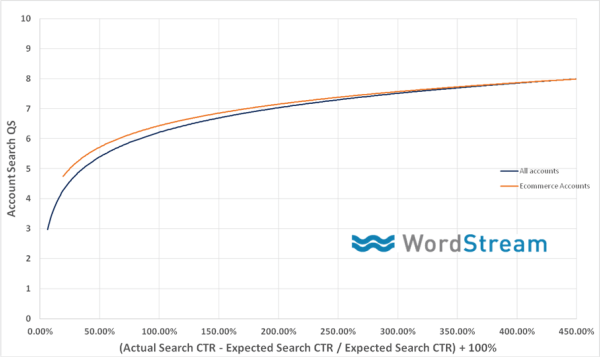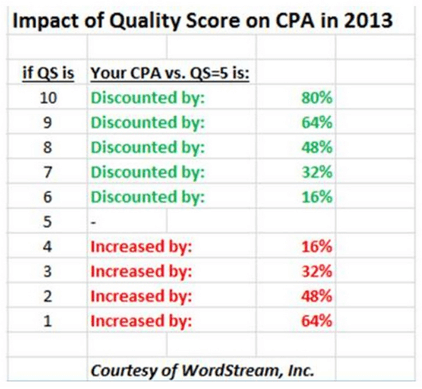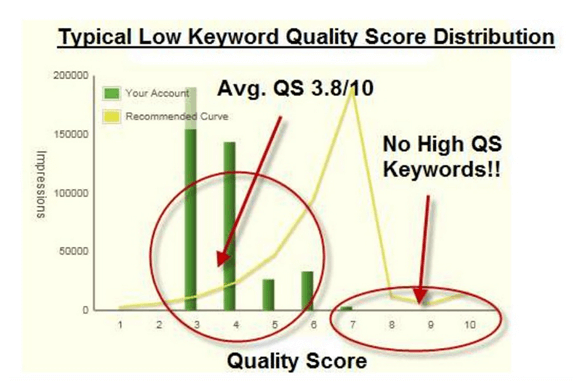In PPC, Low CTR = Low Profits
In my column today, I’ll be talking about a PPC strategy that I first presented at SMX Advanced. Hopefully, it will convince you that pursuing a low click-through rate (CTR) is generally a losing bet. A few years ago, the low CTR strategy might have worked out very well for you — in fact, I’d […]
In my column today, I’ll be talking about a PPC strategy that I first presented at SMX Advanced. Hopefully, it will convince you that pursuing a low click-through rate (CTR) is generally a losing bet.
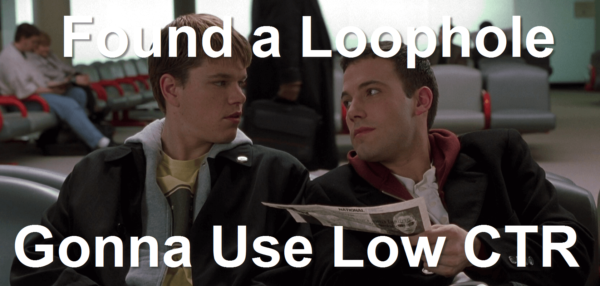
A few years ago, the low CTR strategy might have worked out very well for you — in fact, I’d argue that brands like eBay owe a great deal of their PPC success to low CTR strategies. However, things have changed. If you’re playing by the old rules, you’re being left behind.
Let’s look at the Low CTR Strategy and the surrounding dogma first.
The “Low CTR Strategy”
A low CTR strategy in paid search typically looks like one of two things:
- Going after broader keywords within your niche — keywords with informational, navigational or ambiguous search intent, which tend to suffer from stubbornly low click-through rates, in hopes of getting tons of “free exposure.”
- Employing a strategy to reduce clicks on your ads, either by going after lower ad positions in hopes of finding higher conversion rates, or by sabotaging your ad copy to discourage unqualified buyers to click on your ads.
Google Expects Way More from Your Ads Now
The first big change I’ve noticed is that Google expects far better performance from your ads than they did a few years ago. They’ve really raised the bar in terms of the quality they expect from your ads.
We found that the average CTRs for any given ad position are much higher than you expect, in our analysis of a few thousand advertiser accounts. Each time we run this analysis, we see it trending higher.
But why should you care?
Truth: Quality Score Is Based On Beating Expected CTR
We’ve done some research into the Quality Score equation, and the key finding was that the Quality Score algorithm is essentially just a matter of beating the expected CTR.
A low Quality Score ad is simply an ad or keyword whose CTR falls below Google’s expected, average CTR for a given ad position.
Google Has Changed How The Ad Auction Works
Quality Score matters more and more every day. Over the last three years, Google has quietly changed how the ad auction works.
They haven’t announced this, but we see it in our internal research. Basically, the average quality score today is around 5/10, whereas 4 years ago, it was 7/10.
Quality Score Impacts CPC
As average Quality Scores drop, the value of having an above average QS — in terms of the discount on cost per click — is 200% more than it used to be. The following table shows the huge discounts and penalties that are applied to your CPC, based on your average quality scores.
Truth: Low Quality Score Penalty on CPC is Brutal
Part of the logic behind the Low CTR Strategy is that, by lowering your CTR, you’ll lower your costs. You don’t want high click-through rates because that means you’ll have to pay for more clicks.
The reality is that by pursuing lower CTRs, yes, you’ll pay for fewer clicks — but the cost of those clicks will be up to 400% greater due to the Quality Score tax on low CTR ads.
You’re actually much better off being very picky in your keyword selection and targeting options and trying to get as high a CTR as possible.
Your Low Quality Score Ads With Below Avg. CTRs Don’t Get Shown That Much!
Another rather huge problem with the Low CTR Strategy is that Google has been quietly raising the bar for the quality of ads they want to show in search results. Here’s some new research that we’ve done that shows the exact relationship between quality score and impression share:
Think of impression share as market share for your keywords. Essentially, impression share is how often Google actually shows your ads when people search on the keywords you’re interested in.
(Note: just because you’re interested in a keyword doesn’t mean Google will bother showing it. In fact, they won’t bother showing it at all if your ads are crap. The key takeaway here is that for every 1-point increase or decrease in Quality Score, you can expect to gain or lose an average of 9% impression share.)
Myth: High QS Isn’t Possible In My Industry!
I’ve often heard people say that it’s not possible to get high Quality Scores in their specific industry (as if Google has a personal grudge against them).
Keep in mind that Quality Score is based on beating an expected average CTR for a given ad position. In any industry, essentially half of the accounts out there have above average quality scores and the other half don’t. That’s just how it is — someone may be beating you, but it isn’t Google. This is good, though. It means you have room to improve.
To prove this, I looked back to see if Quality Score was calculated differently in one industry versus another. I found that there were high and low average quality scores for every industry, including:
Real Estate Companies
I looked at real estate companies (the green curve on this graph) and found that the calculations used to determine their Quality Scores weren’t a heck of a lot different from any other industry.
Finance Companies
What about Finance companies — the yellow curve in the graph? Is Google out to get Wall Street? Again, there’s just not a huge difference in terms of how Quality Score is calculated, compared to other industries.
E-Commerce Companies
Same with e-commerce companies — the orange curve in this graph. Again, their Quality Score calculations were very similar to every other industry out there.
When you hear someone say it’s not possible to get a high Quality Score in your industry, the problem could very well be their strategy.
Why Cost-Per-Click (Click-Through Rate & Quality Score) Matters
Why should anyone care about cost per click? After all, if you can sell products or services profitably at $100 cost per click, who the heck cares what the cost per click is? That’s a totally fair point.
The reason you should care is because there’s a strong relationship between Cost Per Click (CPC) and Cost Per Conversion (CPA).
We ran the numbers on millions of dollars of ad spend and found that the higher your CPC, the higher your average CPA. To put it another way, if you’re running profitable PPC campaigns with high CPCs, it would be even more profitable if you could lower your CPCs by raising click-through rates and Quality Scores.
Myth: Position #3 (Or #4, Or #5) Converts Better for Me!
Lots of people tell me, “Larry, I don’t WANT a high click through rate! I don’t want to be in position 1 or 2 and therefore pay for too many clicks. I’d rather be in position 3 or 4 or 5 because those positions somehow get fewer clicks and better conversion rates.”
Conversion Rate Vs. Average Search Position
We looked at conversion rates of ads in the first position and second position and third position (etc.) across thousands of accounts and found that on average, there was no relationship between conversion rate and average search position.
There’s nothing magical from a conversion rate perspective about position 3 — or any other position, for that matter.
Important Note: Click prices and click volume (and thus, Cost-Per-Action) will vary from ad position.
- By bidding up your keywords, you’re essentially buying a higher quantity of clicks in exchange for a higher CPC — as a result, you’ll get more conversions at a higher cost per conversion.
- By bidding down your keywords, you’ll get fewer clicks at a lower CPC, resulting in fewer conversions at a lower cost per conversion.
- The conversion rates of the clicks you acquire for a given keyword will have, on average, the same conversion rate, regardless of ad position.
But My High CTR Ads Have High CPAs!
A friend of mine and fellow SEL paid search columnist Sam Owen, pointed out to me that in one of his accounts, the ads labeled “free” have the highest click through rates (1.1%) but also the worst cost per conversion ($143.75).
@larrykim an example: Notice CTR for “Free” ads is better and higher avg pos, but CPA is prohibitive even w/ low CPC pic.twitter.com/WmqJ4Maocu
— Sam Owen (@SamOwenPPC) March 21, 2014
What the heck is going on here, you ask? My view is that what you’re seeing here is actually either an ad text or a landing page issue.
- “Free” is resonating with searchers — we can tell because they’re clicking. But they’re not converting! It could be worth radically changing the offer to offer something of greater value that truly is free. (i.e., not just a free trial, etc.)
- If the offer can’t be made truly “Free,” then perhaps it’s not worth running an ad that advertises a “Free” product. The high CTR strategy doesn’t mean you should employ trickery to get people to click on your ads.
Truth: Low CTR/Quality Score Keywords Are Killing Your Account
If you’re still not convinced of the futility of a Low CTR Strategy, check this out.
Perhaps the most compelling reason to drop the low CTR/Quality Score keywords and ads is that they’re killing the rest of your account.
Example Crap Account
Take a look at this crappy account here.
The dots on the graph are the keywords in the account, which I’ve plotted based on their CTR and average ad position. See that yellow line there? Keywords above the yellow line are beating the expected CTRs and keywords below the yellow line are not.
You would expect to see a mix of both high and low Quality Scores, right?
Even High CTR Keywords Get Low QS?!
Not so fast. Here’s the account’s QS distribution.
Notice how all of the keywords in the account have Quality Scores of 3, 4, 5 and 6. They have no high Quality Score keywords of 7-10.
What’s happening here is that the low CTR/QS keywords reduce the campaign and account average QS and CTRs, which in turn reduces the QS of all of the keywords in your account, including the good ones.
Example Awesome Account
The reverse is also true. Look at how in this account, most of the keywords are beating the expected CTR.
But some of the keywords are below the expected CTR curve, so you’d expect to see mostly high QS and a few low QS, right?
Even Low CTR Keywords Get High QS!!!
Wrong. Notice how every single keyword in this account has a quality score of 7 or 10, even the keywords with 0% CTR.
What you’re seeing here is something that was only recently disclosed by Google — that the account has so many keywords with high average QS and CTRs that it raises the campaign and account average QS across the account. It floats all boats, including your crap keywords!
Myth: But I Really Need My Low CTR Keywords!
This is another one I hear often: “My boss or client gets mad if he does a search for something he thinks is relevant and doesn’t see our ads.”
This is no reason to use ineffective Low CTR Strategy. Use Remarketing Lists for Search Ads (RLSA)! It’s a great way to raise CTRs and QS on even the most stubbornly low CTR keywords.
In an informal analysis of regular Google search ads vs. RLSA search ads, we found that RLSA ads had:
- 2.5x the average CTR
- ½ the average cost per click
- 1.5x higher QS
Truth: Allocation Strategy Works For Scaling Paid Search
At this point you may be thinking, “If I delete the crap keywords in my account, I’ll lose a good amount of my conversion volume. How do I make up for those lost conversions?” Your boss probably wants more conversions, not less!
The answer is to lean on remarketing and other new display in-market targeting options to scale your paid search efforts.
The 33.3/66.6 Allocation Strategy
Let’s recap here. Your above average Quality Score keywords will have low CPCs, lower CPAs, higher impression shares etc.
Your below average keywords will be doing terrible and will be making it difficult for even your best keywords to succeed.
The idea here is to delete the bottom third of your search marketing campaign (basically the toxic stuff that is killing your account) and allocate that budget to display remarketing or in-market targeting display campaigns.
It works because average remarketing should beat below average search — and because, by deleting the bottom third of your account, you’re helping the rest of your account to be successful.
(Note: In my research here, I’m talking averages. When you’re dealing with one account, or a small number of campaigns, it’s possible that you will see different patterns in your data, but when you look at hundreds or thousands of accounts, the strategies I’ve outline here will hold true.)
Just Say No To Low CTR Strategy & Other AdWords Dogma
Hopefully, I’ve convinced you to just say no to low CTRs and to instead cast a narrow net. Try to get as high a CTR as possible on those keywords, delete the crappy, low CTR keywords that are killing your account, and consider using remarketing and RLSA to scale your search marketing efforts.
Get out of the rut of conventional wisdom and stop doing what everyone is doing. Focus on the lesser known – but totally effective – strategies with the potential for big changes! This is where you’ll find the lowest possible CPAs and a scalable strategy that works.
Check out my full presentation from SMX Advanced below:
Contributing authors are invited to create content for Search Engine Land and are chosen for their expertise and contribution to the search community. Our contributors work under the oversight of the editorial staff and contributions are checked for quality and relevance to our readers. The opinions they express are their own.
Related stories
New on Search Engine Land





